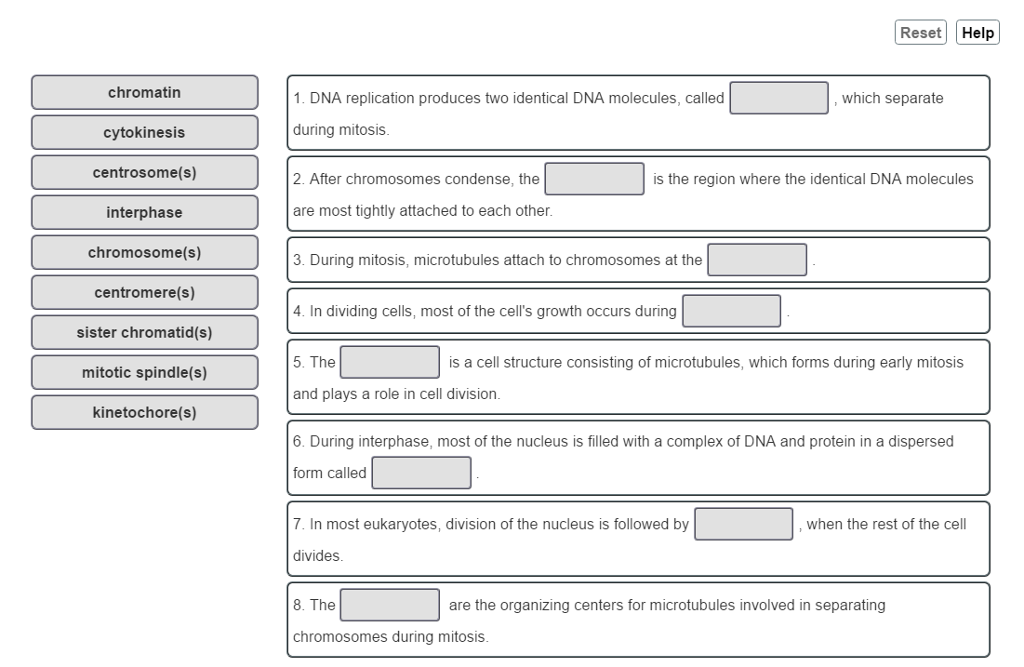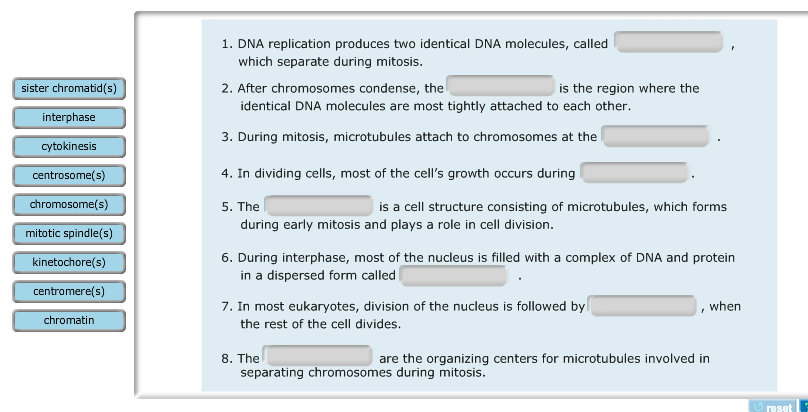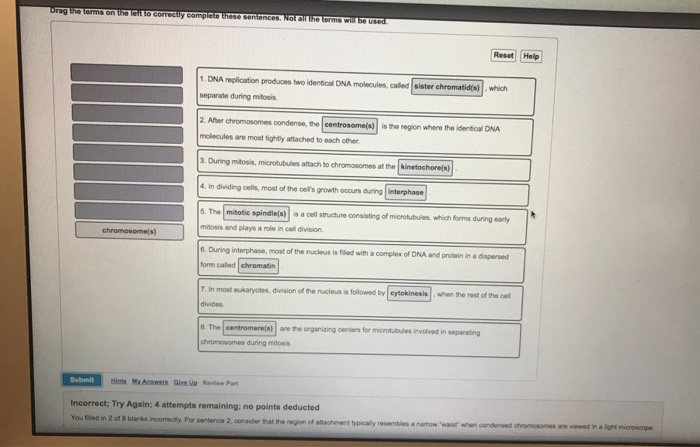Chromosomal Replication Produces Two Identical Sister Chromatids
A chromatid is one of two identical halves of a replicated chromosome. Chromosome replication takes place during interphase of the cell cycle.

Solved Drag The Terms On The Left To Correctly Complete Chegg Com
A sister chromatid refers to the identical copies formed by the DNA replication of a chromosome with both copies joined together by a common centromere.

. SCE possibly occurred during DNA synthesis either due to some replication error or due to inhibition of DNA replication 44. At mitosis a diploid parent cell passes through four phases. Hence each replicated chromosome is composed of two sister chromatids.
Mitosis produces two daughter cells that are genetically identical to each other and to the parental cell. Each one appears as two sister chromatids constricted at a specific point along their length the centromere. Following replication each chromosome is composed of two DNA molecules.
Yes thats when the two sister. DNA replication produces two identical DNA molecules called which separate during mitosis. A sister chromatid refers to the identical copies chromatids formed by the DNA replication of a chromosome with both copies joined together by a common centromere.
Division in meiosis I occurs in four phases. Sister chromatid exchange SCE is the reciprocal exchange of chromatin between two identical sister chromatids. It also prepares for thenext stage.
Telophase I and cytokinesis. G2 is the next stage and the cell again checks for errors and mutations in the DNA and then doubles up its organelles and cellular inclusions in preparation for mitosis. Chromosomes begin to condense.
During late prophase the nuclear envelope disintegrates and. After DNA replication the cells is still genetically diploid 2N chromosome number but has 4X DNA content because each chromosome has replicated its DNA. The sister chromatids are genetically identical and joined at the centromere.
I do not have an account I want to register. Sister chromatids After chromosomes condense the _______ is the region where the identical DNA molecules are most tightly attached to each other. Sister chromatids are two identical chromatids resulting in DNA replication during the S phase of interphase.
If you were to observe a cell containing 3 pairs of homologous chromosomes during a normal cell cycle how many sister chromatids would you expect to find when mitosis. Following DNA replication the chromosome consists of two identical structures called sister chromatids which are joined at the centromere. The two identical copieseach forming one half of the replicated chromosomeare called chromatids.
Prophase metaphase anaphase and telophase. This assay examines the ability of a. Sister chromatids are two identical copies of the same chromosome formed by DNA replication attached to each other by a structure called the centromere.
In other words a sister chromatid may also be said to be one-half of the duplicated chromosome. That is where the Interphase stage ends. During cell division they are separated from each other and each daughter cell receives one copy of the chromosome.
- when replication is complete each chromosome has two identical siter chromatids that are attached at the centromere - a reduction division. Each chromosome now consists of a. Published 12052018 on subject Biology by Guest.
Sister chromatids are identical to each other. Correct answer to the question Does chromosomal replication produce two identical sister chromatids. A diploid cell starts with 2N chromosomes and 2X DNA content.
DNA replication produces two identical DNA molecules called _____ which separate during mitosis. A sister chromatid is a one-half of a replicated chromosome. The two sister chromatids are separated from each other into two different cells during mitosis or during the second division of meiosis.
A pair of sister chromatids is called a dyad. During cell division the chromosomes first replicate so that each daughter cell receives a complete set of chromosomes. The meaning of SISTER CHROMATID is either of the two identical chromatids that are formed by replication of a chromosome during the S phase of the cell cycle are joined by a centromere and segregate into separate daughter cells during anaphase.
Under normal conditions each round of mitosis should result in two identical daughter cells. Does chromosomal replication produce two identical sister chromatids. Differences between Sister Chromatids and Non-Sister Homologous Chromatids.
Log In Join Now. The chemicals nonylphenol and BPA both disrupt cell cycles resulting in chromosomal abnormalities. A full set of sister chromatids is created during the synthesis phase of.
DNA is synthesized during the S phase or synthesis phase of interphase to ensure that each cell ends up with the correct number of chromosomes after cell. Sister chromatids are two identical copies of a single replicated chromosome that are connected by a centromere. The chromosomes double up to form 2 identical sister chromatids that will be divided once the cell forms an identical daughter cell.
They are joined together by the centromere. I have an account sign in. Only in mitosis do chromosomes become visible by light microscopy.
SCE formation is an early indicator of chromosome instability in response to genotoxic agents. During mitosis microtubules attach to chromosomes at the. In dividing cells most of the cells growth occurs during.
After chromosomes condense the is the region where the identical DNA molecules are most tightly attached to each other. One of them is the exact. Does chromosomal replication produce two identical sister chromatids.
The single centrosome replicates forming two centrosomes. In other words DNA replication itself increases the amount of DNA but does not yet increase the number of chromosomes. Prophase I typically occupies more than 90 of the time required for meiosis.

Solved Dna Replication Produces Two Identical Dna Molecules Chegg Com

Solved Drag The Terms On The Left To Correctly Complete Chegg Com

Solved Chromatin Cytokinesis Centrosome S Interphase Chegg Com
No comments for "Chromosomal Replication Produces Two Identical Sister Chromatids"
Post a Comment